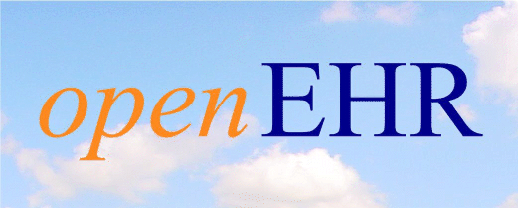Data Structures Information Model
| Editors: {T Beale, S Heard}a, {D Kalra, D Lloyd}b | ||
|---|---|---|
| Revision: 1.7 | Pages: 39 | Date of issue: 26 Sep 2006 |
- a.
- Ocean Informatics
- b.
- Centre for Health Informatics and Multi-professional Education, University College London
Keywords: EHR, reference model, openehr, data structures
| EHR Extract | ||||||
|---|---|---|---|---|---|---|
| EHR | Demographic | Integration | Template OM | |||
| Composition | openEHR Archetype Profile | |||||
| Security | Common | Archetype OM | ADL | |||
| Data Structures | ||||||
| Data Types | ||||||
| Support | ||||||
© 2003-2007 The openEHR Foundation.
The openEHR Foundation is an independent, non-profit community, facilitating the sharing of health records by consumers and clinicians via open-source, standards-based implementations.
| Founding | David Ingram, Professor of Health Informatics, |
|---|---|
| Chairman | CHIME, University College London |
| Founding | Dr P Schloeffel, Dr S Heard, Dr D Kalra, D Lloyd, T Beale |
| Members | |
| email: info@openEHR.org web: http://www.openEHR.org |
Data Structures Information Model
Rev 1.7
Copyright Notice
© Copyright openEHR Foundation 2001 - 2007 All Rights Reserved
- This document is protected by copyright and/or database right throughout the world and is owned by the openEHR Foundation.
- You may read and print the document for private, non-commercial use.
- You may use this document (in whole or in part) for the purposes of making presentations and education, so long as such purposes are non-commercial and are designed to comment on, further the goals of, or inform third parties about, openEHR.
- You must not alter, modify, add to or delete anything from the document you use (except as is permitted in paragraphs 2 and 3 above).
- You shall, in any use of this document, include an acknowledgement in the form: "© Copyright openEHR Foundation 2001-2007. All rights reserved. www.openEHR.org"
- This document is being provided as a service to the academic community and on a non-commercial basis. Accordingly, to the fullest extent permitted under applicable law, the openEHR Foundation accepts no liability and offers no warranties in relation to the materials and documentation and their content.
- If you wish to commercialise, license, sell, distribute, use or otherwise copy the materials and documents on this site other than as provided for in paragraphs 1 to 6 above, you must comply with the terms and conditions of the openEHR Free Commercial Use Licence, or enter into a separate written agreement with openEHR Foundation covering such activities. The terms and conditions of the openEHR Free Commercial Use Licence can be found at http://www.openehr.org/free_commercial_use.htm
Date of Issue: 26 Sep 2006 Page 2 of 39 Editors:{T Beale, S Heard}, {D Kalra, D Lloyd}
© 2003-2007 The openEHR Foundation. email: info@openEHR.org web: http://www.openEHR.org
Data Structures Information Model
Rev 1.7
Amendment Record
| Issue | Details | Who | Completed |
|---|---|---|---|
| R E L E A S E 1.0.1 | |||
| 1.7 | CR-000200. Correct Release 1.0 typographical errors. Minor cosmetic changes to diagrams. Correct return types of ITEM_TABLE functions to CLUSTER rather than List<ELEMENT>. CR-000207: Change ITEM_TABLE columns to rows. CR-000219: Use constants instead of literals to refer to terminology in RM. CR-000220: Tighten semantics of HISTORY.period and EVENT.time. | D Lloyd, T Beale S Heard R Chen A Patterson | 26 Sep 2006 |
| R E L E A S E 1.0 | |||
| 1.6 | CR-000014. Adjust History. Major simplifcation to package; make Events absolute in time. CR-000155: Summary data. CR-000183. Remove root node from ITEM_TREE. CR-000185. Improved EVENT model. CR-000155: Summary data. CR-000192: Add display-as-absolute facility to delta Events in History (added explanation only). CR-000193: Simplify INTERVAL_EVENT for archetyping and paths. Revert to one math function per INTERVAL_EVENT. CR-000196: Rename HISTORY.items to events. CR-000192. Support change, increase and decrease Events in History. | S Heard T Beale S Heard G Grieve S Heard S Heard S Heard G Grieve S Heard S Heard S Heard S Heard D Lloyd | 16 Dec 2005 |
| R E L E A S E 0.95 | |||
| 1.5.1 | CR-000048. Pre-release review of documents. Fixed HISTORY UML diagram - remove superfluous T:XXX (no semantic change). Converted parameter types to UML box form. | D Lloyd | 22 Feb 2005 |
| 1.5 | CR-000101. Improve modelling of Structure classes. CR-000100. Correct inheritance error in ITEM_STRUCTURE package. CR-000024. Revert meaning to STRING and rename as archetype_node_id. CR-000118. Make package names lower case. CR-000123. EVENT should inherit from LOCATABLE. CR-000124. Fix path syntax in data structures IM document. | DSTC T Beale S Heard, T Beale T Beale Rong Chen T Beale | 10 Dec 2004 |
| R E L E A S E 0.9 |
Editors:{T Beale, S Heard}, {D Kalra, D Lloyd} Page 3 of 39 Date of Issue: 26 Sep 2006
© 2003-2007 The openEHR Foundation. email: info@openEHR.org web: http://www.openEHR.org
Data Structures Information Model
Rev 1.7
| Issue | Details | Who | Completed |
|---|---|---|---|
| 1.4 | CR-000019. Add HISTORY & STRUCTURE supertype. CR-000028. Change name of STRUCTURE class to avoid clashes. CR-000089. Remove ITEM.displayed. CR-000091. Correct anomalies in use of CODE_PHRASE and DV_CODED_TEXT. CR-000067. Change EVENT class to enable math function interval measurements. Renamed EVENT.duration and SINGLE_EVENT.duration to width. Formally validated using ISE Eiffel 5.4. | T Beale H Frankel DSTC T Beale S Heard | 09 Mar 2004 |
| 1.3.3 | CR-000041. Visually differentiate primitive types in openEHR documents. | D Lloyd | 04 Sep 2003 |
| 1.3.2 | CR-000013 Rename key classes - rename COMPOUND to CLUSTER to conform with CEN 13606. | D Kalra, T Beale | 20 Jun 2003 |
| 1.3.1 | Improved heading layout, package naming. Made HIS-TORY.is_periodic a function. | T Beale, Z Tun | 18 Mar 2003 |
| 1.3 | Formally validated using ISE Eiffel 5.2. No changes. | T Beale | 20 Feb 2003 |
| 1.2.1 | Minor corrections to terminology_id invariants. | Z Tun | 08 Jan 2003 |
| 1.2 | Defined packages properly and moved HISTORY classes from EHR RM. No change to semantics. | T Beale | 18 Dec 2002 |
| 1.1.1 | Minor corrections: SINGLE_S new function. | T Beale | 10 Nov 2002 |
| 1.1 | Minor adjustments due to change in DV_CODED_TEXT. | T Beale | 1 Nov 2002 |
| 1.0 | Taken from Common RM. | T Beale | 11 Oct 2002 |
Acknowledgements
The work reported in this paper has been funded in by a number of organisations, including Ocean Informatics; The University College, London; Australia; The Cooperative Research Centres Program through the Department of the Prime Minister and Cabinet of the Commonwealth Government of Australia.
Thanks to Grahame Grieve of Kestral Computing for general input and examples relating to History data.
Date of Issue: 26 Sep 2006 Page 4 of 39 Editors:{T Beale, S Heard}, {D Kalra, D Lloyd}
© 2003-2007 The openEHR Foundation. email: info@openEHR.org web: http://www.openEHR.org
Data Structures Information Model
Rev 1.7
Table of Contents
1 Introduction.............................................................................. 7
2 Background............................................................................... 9
3 Overview ..................................................................................11
3.2.1 DATA_STRUCTURE Class ..........................................................12
4 Item Structure Package ......................................................... 13
4.2 CEN EN13606 Encoding Rules...........................................................14
4.2.1 ITEM_SINGLE .............................................................................14
4.2.3 ITEM_TABLE ...............................................................................14
4.2.4 ITEM_TREE..................................................................................14
4.3.1 ITEM_STRUCTURE Class...........................................................14
4.3.2 ITEM_SINGLE Class....................................................................14
4.3.3 ITEM_LIST Class..........................................................................15
4.3.4 ITEM_TABLE Class .....................................................................16
4.3.5 ITEM_TREE Class ........................................................................18
4.4.1 ITEM_SINGLE Instance Structure................................................19
4.4.2 ITEM_LIST Instance Structure .....................................................19
4.4.3 ITEM_TABLE Instance Structure .................................................20
4.4.4 ITEM_TREE Instance Structure....................................................20
5 Representation Package ........................................................ 23
5.2.2 CLUSTER Class ............................................................................24
5.2.3 ELEMENT Class ...........................................................................25
6 History Package...................................................................... 27
6.2.1 HISTORY<T: ITEM_STRUCTURE> Class.................................33
6.2.2 EVENT <T: ITEM_STRUCTURE> Class....................................34
6.2.3 POINT_EVENT <T: ITEM_STRUCTURE> Class......................35
6.2.4 INTERVAL_EVENT <T: ITEM_STRUCTURE> Class...............35
Editors:{T Beale, S Heard}, {D Kalra, D Lloyd} Page 5 of 39 Date of Issue: 26 Sep 2006
© 2003-2007 The openEHR Foundation. email: info@openEHR.org web: http://www.openEHR.org
Data Structures Information Model
Rev 1.7
6.3 History Instance Structures.................................................................. 36
6.3.2 5-minute Blood Pressure Averages ...............................................36
A References............................................................................... 37
Date of Issue: 26 Sep 2006 Page 6 of 39 Editors:{T Beale, S Heard}, {D Kalra, D Lloyd}
© 2003-2007 The openEHR Foundation. email: info@openEHR.org web: http://www.openEHR.org
Data Structures Information Model Introduction Rev 1.7
Introduction
1.1 Purpose
This document describes the common data structures used in openEHR reference model, including lists, tables, trees, and history, along with one possible data representation (hierarchical) which is compatible with the CEN 13606 EHCR standard.
The intended audience includes:
- Standards bodies producing health informatics standards;
- Software development organisations using openEHR;
- Academic groups using openEHR;
- The open source healthcare community;
- Medical informaticians and clinicians intersted in health information;
- Health data managers.
1.2 Related Documents
Prerequisite documents for reading this document include:
- The openEHR Architecture Overview
- The openEHR Modelling Guide
- The openEHR Support Information Model
- The openEHR Data Types Information Model
1.3 Status
This document is under development, and is published as a proposal for input to standards processes and implementation works.
This document is available at http://svn.openehr.org/specification/TAGS/Release 1.0.1/publishing/architecture/rm/data_structures_im.pdf .
The latest version of this document can be found at http://svn.openehr.org/specifica tion/TRUNK/publishing/architecture/rm/data_structures_im.pdf .
Blue text indicates sections under active development.
1.4 Peer review
Areas where more analysis or explanation is required are indicated with “to be continued” paragraphs like the following:
To Be Continued: more work required
Reviewers are encouraged to comment on and/or advise on these paragraphs as well as the main content. Please send requests for information to info@openEHR.org. Feedback should preferably be provided on the mailing list openehr-technical@openehr.org, or by private email.
Editors:{T Beale, S Heard}, {D Kalra, D Lloyd} Page 7 of 39 Date of Issue: 26 Sep 2006
© 2003-2007 The openEHR Foundation. email: info@openEHR.org web: http://www.openEHR.org
Introduction Data Structures Information Model Rev 1.7
1.5 Conformance
Conformance of a data or software artifact to an openEHR Reference Model specification is determined by a formal test of that artifact against the relevant openEHR Implementation Technology Specification(s) (ITSs), such as an IDL interface or an XML-schema. Since ITSs are formal, automated derivations from the Reference Model, ITS conformance indicates RM conformance.
Date of Issue: 26 Sep 2006 Page 8 of 39 Editors:{T Beale, S Heard}, {D Kalra, D Lloyd}
© 2003-2007 The openEHR Foundation. email: info@openEHR.org web: http://www.openEHR.org
Data Structures Information Model Background Rev 1.7
Background
2.1 Requirements
The requirements for structured data in the EHR and other systems are essentially that low-level data can be expressed in standard structures. The structures which are commonly required are as follows:
- single values, e.g. weight, height, blood sugar;
- lists of named/numbered elements, e.g. blood test results;
- tables of values with named columns and/or named rows, e.g. visual acuity results;
- trees of values, e.g. biochemistry, microbiology results;
- histories of values, each of which takes any of the above forms, e.g. a time series of blood pressures, glucose levels, or imaging data.
2.2 Design Principles
The design principle which particularly applies to the data structure models described here is the need to provide explicit specifications for logical structures using the same generic representation, such as hierarchy. The logical structures include tables, lists, trees, and the concept of history.
Regardless of whether such structures are treated as pure presentation or as having semantic significance, there are at various reasons for explicitly including the semantics of logical structures which are represented in a generic way such as hierarchy, including:
- it is essential for interoperability that a structure such as a logical table, list or linear history be encoded into the generic representation in the same way by all senders and receivers of information, otherwise there is no guarantee that any communicating party’s software processes the structures in the intended fashion;
- software implementors can develop software which explicitly captures the logical structures as functional interfaces which are used as the only way of building such structures. Such interfaces (assuming they are bug-free) guarantee that all application software always creates correct structures - there is no need to rely on caller software each time making low level calls to create a table or list out of hierarchy elements;
- the use of a functional interface for such types means that application software at the receiver’s end can always process incoming information in its intended form, enabling correct presentation of data on the screen.
One of the motivations for defining logical data structures explicitly is to remove the ambiguity in recording structure and time in previous EHR specifications and standards, such as CEN 13606, GEHR, GEHR Australia, and HL7v3 CDA specifications. The alternative in the past was to simply use generic hierarchical structures; there was no agreement in the standard about how a table might be represented, similarly, time had no standard representation. Where single values were recorded, an attribute meaning ‘time of recording’ was set appropriately; if a time series was required, there was no clear guideline as to how to model it. One way would have been to build a double list which is logically a two column table, whose first column was time-point data, but many other approaches are possible. The standardised approach removes all such ambiguity, and improves the quality of data and software.
Editors:{T Beale, S Heard}, {D Kalra, D Lloyd} Page 9 of 39 Date of Issue: 26 Sep 2006
© 2003-2007 The openEHR Foundation. email: info@openEHR.org web: http://www.openEHR.org
Background Data Structures Information Model Rev 1.7
Date of Issue: 26 Sep 2006 Page 10 of 39 Editors:{T Beale, S Heard}, {D Kalra, D Lloyd}
© 2003-2007 The openEHR Foundation. email: info@openEHR.org web: http://www.openEHR.org
Data Structures Information Model Overview Rev 1.7
Overview
The rm.data_structures package contains two packages: the item_structure package and the history package. The first describes generic, path-addressable data structures, while the latter describes a generic notion of linear history, for recording events in past time. The data_structures package is illustrated in FIGURE 1 .
LOCATABLE (rm.common.archetyped)
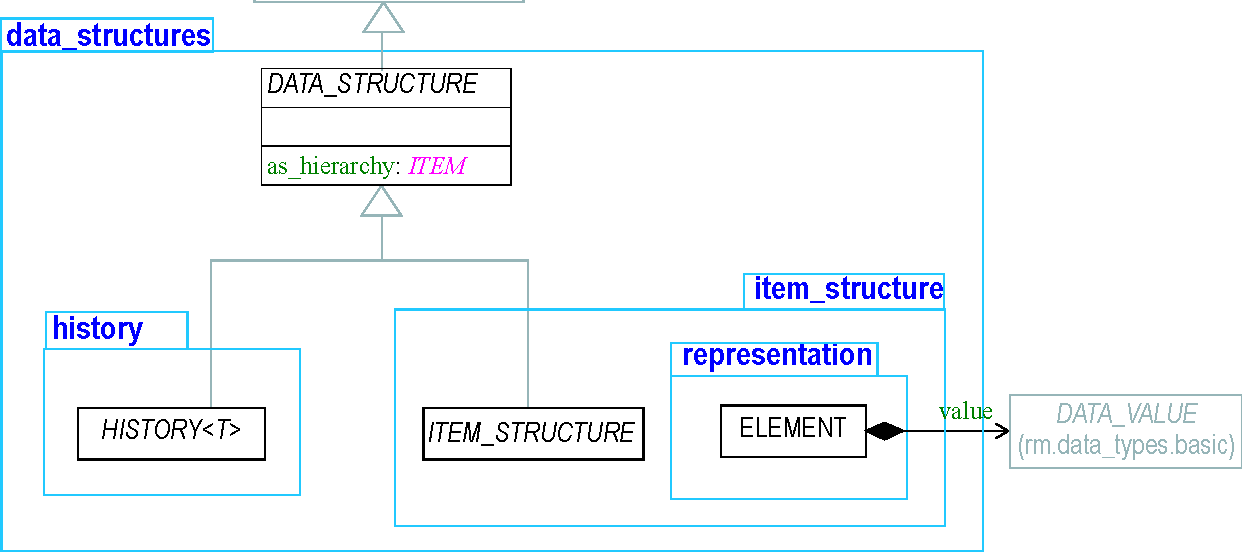
FIGURE 1 rm.data_structures Package
The data_structures package itself contains a single class, DATA_STRUCTURE, which is the ancestor of all openEHR data structures. Its only feature is the function as_hierarchy, which is implemented by each subtype of DATA_STRUCTURE, in order to generate a physical representation of the structure in CEN EN13606 form. The 13606 form is usually less optimal than the openEHR form, but is compatible with the less semantically rich standard, and is guaranteed (in theory) to be comprehensible to other systems which support CEN EN13606 as an interoperability standard.
3.1 Instance Structures
Diagrams of typical instances of the structures are included throughout this document. Each instance of shown in both physical and logical form. The physical form shows the instances which will occur in data if the structure is implemented using the representation package. The logical form shows the same instance in a logical form only - i.e. hiding the physical implementation. Only the latter form is used in other openEHR documents. In all instance diagrams, the following shorthand is used for well-known attribute names:
- “m = xxxx” - means “meaning = xxxx”, i.e. the meaning of the archetype_node_id attribute inherited from the LOCATABLE class.
- “n = xxxx” - means “name = xxxx”, i.e. the value of the name attribute inherited from the LOCATABLE class.
- “v = xxxx” - means “value = xxxx”, i.e. the value of the value attribute from the ELEMENT class.
Editors:{T Beale, S Heard}, {D Kalra, D Lloyd} Page 11 of 39 Date of Issue: 26 Sep 2006
© 2003-2007 The openEHR Foundation. email: info@openEHR.org web: http://www.openEHR.org
| Overview Rev 1.7 | Data Structures Information Model | |
|---|---|---|
| 3.2 | Class Descriptions | |
| 3.2.1 | DATA_STRUCTURE Class |
| CLASS | DATA_STRUCTURE (abstract) | |
|---|---|---|
| Purpose | Abstract parent class of all data structure types. Includes the as_hierarchy function which can generate the equivalent CEN EN13606 single hierarchy for each subtype’s physical representation. For example, the physical representation of an ITEM_LIST is List<ELEMENT>; its implementation of as_hierarchy will generate a CLUSTER containing the set of ELEMENT nodes from the list. | |
| Inherit | LOCATABLE | |
| Function | Signature | Meaning |
| as_hierarchy: ITEM | Hierarchical equivalent of the physical representation of each subtype, compatible with CEN EN 13606 structures. | |
| Invariants | As_hierarchy_exists: as_hierarchy /= Void | |
Date of Issue: 26 Sep 2006 Page 12 of 39 Editors:{T Beale, S Heard}, {D Kalra, D Lloyd}
© 2003-2007 The openEHR Foundation. email: info@openEHR.org web: http://www.openEHR.org
Data Structures Information Model Item Structure Package Rev 1.7
Item Structure Package
4.1 Overview
The Item_Structure classes presented here are a formalisation of the need for generic, archetypable data structures, and are used by all openEHR reference models.
The subtypes of the ITEM_STRUCTURE class explicitly model the logical data structure types which typically occur in health record data, and include ITEM_SINGLE (for single values such as a patient weight), ITEM_LIST (for lists such as parts of an address), ITEM_TREE (for hierarchically structured data such as a microbiology report) and ITEM_TABLE (for tabular data such as visual acuity or reflex test results). Each of these classes defines a functional interface, has an optimal physical representation using the basic types CLUSTERand ELEMENTfrom the representationpackage, and can generate a CEN EN13606-compliant hierarchical representation of its data. Any system implementing these types is guaranteed to create data which represents the logical structures of lists, tables and trees identically.
Data values are connected to spatial structures via the value attribute of the ELEMENT class of the Representation cluster. This class also carries an important attribute null_flavor, whose value indicates how to read the value. A small domain termlist containing values such as “unknown”, “not disclosed”, “undetermined”, etc, as described in the Flavours of Null vocabulary in the openEHR Support Information Model.
The openEHR class model for spatial structures is illustrated in FIGURE 2 . It should be noted that these classes (ITEM_LIST etc) are not equivalents of similarly named classes (such as List<T>) in most data structure libraries - they also include per-node name, archetype_node_id and leaf node value and null flavour, and path capabilities.
LOCATABLE (rm.common.archetyped)
DATA_STRUCTURE
(rm.data_structures)
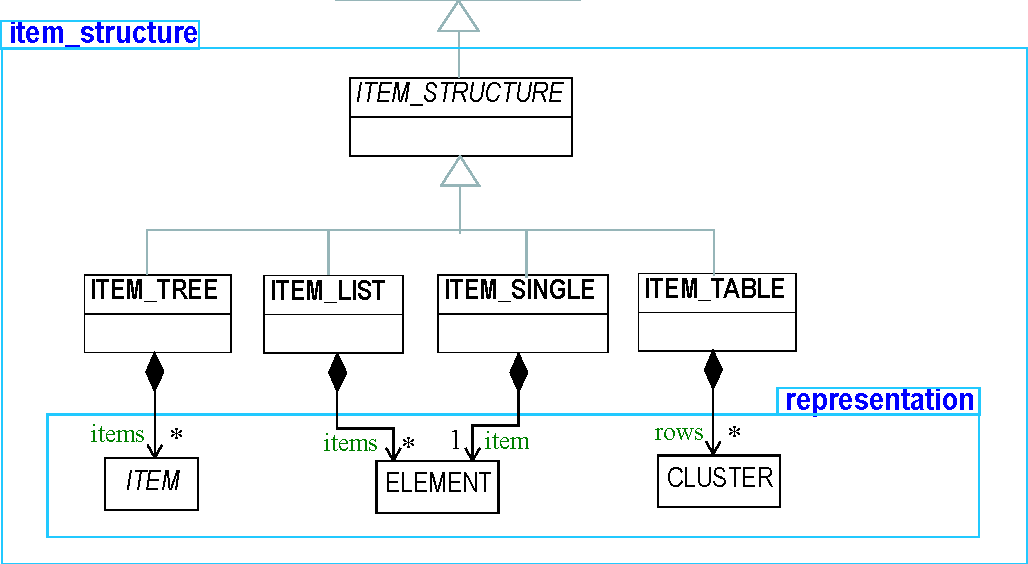
FIGURE 2 rm.data_structures.item_structure Package
Editors:{T Beale, S Heard}, {D Kalra, D Lloyd} Page 13 of 39 Date of Issue: 26 Sep 2006
© 2003-2007 The openEHR Foundation. email: info@openEHR.org web: http://www.openEHR.org
Item Structure Package Data Structures Information Model Rev 1.7
4.2 CEN EN13606 Encoding Rules
4.2.1 ITEM_SINGLE
An ITEM_SINGLE object is encoded in EN13606 as a single ELEMENT object.
4.2.2 ITEM_LIST
An ITEM_LIST object is encoded in EN13606 as a CLUSTER object containing the set of ELEMENTs from the openEHR list.
4.2.3 ITEM_TABLE
The ITEM_TABLE encoding rules are as follows:
- Each row is encoded as a Cluster containing a number of Elements, each corresponding to the value of a column in that row.
- An empty/void column value for a row is represented by an Element containing no value, and with null_flavour set.
- The names of the Element in a row are the column names.
- The names of the containing Cluster of each row is the stringified number of the row in the overall table.
4.2.4 ITEM_TREE
Data of an ITEM_TREE instance are simply replicated as is to produce the correct EN13606 hierarchical form.
4.3 Class Descriptions
4.3.1 ITEM_STRUCTURE Class
| CLASS | ITEM_STRUCTURE (abstract) | |
|---|---|---|
| Purpose | Abstract parent class of all spatial data types. | |
| GEHR | G1_HIERARCHICAL_PROPOSITION | |
| HL7v3 | CDA Structure abstract type. | |
| Inherit | DATA_STRUCTURE | |
| Abstract | Signature | Meaning |
| Invariants | ||
4.3.2 ITEM_SINGLE Class

Date of Issue: 26 Sep 2006 Page 14 of 39 Editors:{T Beale, S Heard}, {D Kalra, D Lloyd}
© 2003-2007 The openEHR Foundation. email: info@openEHR.org web: http://www.openEHR.org
Data Structures Information Model Item Structure Package Rev 1.7
| CLASS | ITEM_SINGLE | |
|---|---|---|
| Use | Used to represent any data which is logically a single value, such as a person’s height or weight. | |
| GEHR | G1_SIMPLE_PROPOSITION | |
| HL7v3 | CDA Item type. | |
| Inherit | ITEM_STRUCTURE | |
| Attributes | Signature | Meaning |
| 1..1 | item: ELEMENT | |
| Functions | Signature | Meaning |
| as_hierarchy: ELEMENT | Generate a CEN EN13606-compatible hierarchy consisting of a single ELEMENT. | |
| Invariants | Item_valid: item /= Void | |
4.3.3 ITEM_LIST Class
| CLASS | ITEM_LIST | |
|---|---|---|
| Purpose | Logical list data structure, where each item has a value and can be referred to by a name and a positional index in the list. The list may be empty. | |
| Use | Used to represent any data which is logically a list of values, such as blood pressure, most protocols, many blood tests etc. | |
| MisUse | Not to be used for time-based lists, which should be represented with the proper temporal class, i.e. HISTORY. | |
| GEHR | G1_LIST_PROPOSITION | |
| HL7v3 | CDA 1.0 List Entrytype. | |
| Inherit | ITEM_STRUCTURE | |
| Attributes | Signature | Meaning |
| 0..1 | items: List<ELEMENT> | Physical representation of the list. |
| Functions | Signature | Meaning |
| 1..1 | item_count: Integer | Count of all items |
| 1..1 | names: List<DV_TEXT> | Retrieve the names of all items |
Editors:{T Beale, S Heard}, {D Kalra, D Lloyd} Page 15 of 39 Date of Issue: 26 Sep 2006
Item Structure Package Data Structures Information Model Rev 1.7
| CLASS | ITEM_LIST | |
|---|---|---|
| named_item(a_name:String): ELEMENT | Retrieve the item with name ‘a_name’ | |
| ith_item(i:Integer): ELEMENT | Retrieve the i-th item with name | |
| as_hierarchy: CLUSTER | Generate a CEN EN13606-compatible hierarchy consisting of a single CLUSTER containing the ELEMENTs of this list. | |
| Invariants | Valid_structure: items.forall(i:ITEM | i.type = “ELEMENT”) Names_valid: names /= Void | |
4.3.4 ITEM_TABLE Class
| CLASS | ITEM_TABLE | |
|---|---|---|
| Purpose | Logical relational database style table data structure, in which columns are named and ordered with respect to each other. Implemented using Cluster-per-row encoding. Each row Cluster must have an identical number of Elements, each of which in turn must have identical names and value types in the corresponding postions in each row. Some columns may be designated ‘key’ columns, containing key data for each row, in the manner of relational tables. This allows row-naming, where each row represents a body site, a blood antigen etc. All values in a column have the same data type. | |
| Use | Used to represent any data which is logically a table of values, such as blood pressure, most protocols, many blood tests etc. | |
| MisUse | Not used for time-based data, which should be represented with the temporal class HISTORY.. The table may be empty. | |
| CEN | n/a | |
| GEHR | G1_TABLE_PROPOSITION, G1_MATRIX_PROPOSITION | |
| HL7v3 | RIM structured types Table_structure, Table_cell, Table etc ; CDA 1.0 Table Entry type. | |
| Inherit | ITEM_STRUCTURE | |
| Attributes | Signature | Meaning |
| 0..1 | rows: List<CLUSTER> | Physical representation of the table as a list of CLUSTERs, each containing the data of one row of the table. |
| Functions | Signature | Meaning |
Date of Issue: 26 Sep 2006 Page 16 of 39 Editors:{T Beale, S Heard}, {D Kalra, D Lloyd}
Data Structures Information Model Item Structure Package Rev 1.7
| CLASS | ITEM_TABLE | |
|---|---|---|
| 1..1 | row_count: Integer | Return the number of rows |
| 1..1 | column_count: Integer | Return the number of columns |
| 1..1 | row_names: List<DV_TEXT> | Return the row names |
| 1..1 | column_names: List<DV_TEXT> | Return the column names |
| ith_row(i:Integer): CLUSTER require i >0 and i < row_count | Return the i-th row | |
| has_row_with_name(a_key: String): Boolean require a_key /= Void and then not a_key.empty | True if there is a row whose first column has the name ‘a_key’ | |
| has_column_with_name(a_key: String): Boolean require a_key /= Void and then not a_key.empty | True if there is a column with name ‘a_key’ | |
| named_row(a_key: String): CLUSTER require has_row_with_name(a_key) | Return the row whose first column has the name ‘a_key’ | |
| has_row_with_key (keys: Set<String>): Boolean | True if there is a row whose first n columns have the names in ‘keys’ | |
| row_with_key (keys: Set<String>): CLUSTER require has_row_with_key(keys) | Return the row whose first n columns have names equal to the values in ‘keys’ | |
| element_at_cell_ij (i, j:Integer): ELEMENT require i >= 1 and i <= column_count j >= 1 and j <= row_count | Return the element at the column i, row j. | |
| element_at_named_cell (row_key, col_key:String): ELEMENT require has_row_with_name(row_key) has_column_with_name(column_key) | Return the element at the row whose first column has the name ‘row_key’ and column has the name ‘col_key’ | |
Editors:{T Beale, S Heard}, {D Kalra, D Lloyd} Page 17 of 39 Date of Issue: 26 Sep 2006
Item Structure Package Data Structures Information Model Rev 1.7
| CLASS | ITEM_TABLE | |
|---|---|---|
| as_hierarchy: CLUSTER | Generate a CEN EN13606-compatible hierarchy consisting of a single CLUSTERcontaining the CLUSTERs representing the columns of this table. | |
| Invariants | Valid_structure: rows.forall(items.forall(instance_of(“ELEMENT”))) Column_names_valid: column_names /= Void | |
4.3.5 ITEM_TREE Class
| CLASS | ITEM_TREE | |
|---|---|---|
| Purpose | Logical tree data structure. The tree may be empty. | |
| Use | Used to represent data which are logically a tree such as audiology results, microbiology results, biochemistry results. | |
| MisUse | ||
| CEN | The CEN cluster is effectively the only data structure available in CEN, and is equivalent to the ITEM_TREEtype. | |
| GEHR | G1_TREE_PROPOSITION | |
| HL7v3 | This can be constructed with CDA 1.0 Lists. Act and Act_relationship are the closest correspondents in the HL7v3 RIM. | |
| Inherit | ITEM_STRUCTURE | |
| Attributes | Signature | Meaning |
| 0..1 | items: LIST<ITEM> | Physical representation of the tree. |
| Functions | Signature | Meaning |
| has_element_path(a_path:String): Boolean | True if path ‘a_path’ is a valid leaf path | |
| element_at_path(a_path:String): ELEMENT require has_element_path(a_path) | Return the leaf element at the path ‘a_path’ | |
| as_hierarchy: CLUSTER | Generate a CEN EN13606-compatible hierarchy, which is the same as the tree’s physical representation. | |
| Invariants | ||
Date of Issue: 26 Sep 2006 Page 18 of 39 Editors:{T Beale, S Heard}, {D Kalra, D Lloyd}
| Data Structures Information Model | Item Structure Package Rev 1.7 | |
|---|---|---|
| 4.4 | Instance Structures | |
| 4.4.1 | ITEM_SINGLE Instance Structure | |
FIGURE 3 illustrates a ITEM_SINGLE instance, in both physical and logical forms.
ITEM_SINGLE
n = “weight” m = “weight”
![]() item
item

weight = 85kg
FIGURE 3 Instance Structure of ITEM_SINGLE
4.4.2 ITEM_LIST Instance Structure
FIGURE 4 illustrates a typical ITEM_LIST structure, in this case for a BP protocol.
ITEM_LIST
Physical Form
n = “BP protocol” m = “BP protocol”
items
BP protocol device = sphygmomanometer cuff size = wide position = seated
Logical Form
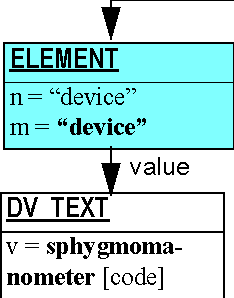
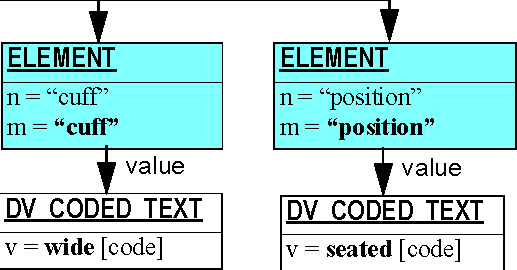
FIGURE 4 ITEM_LIST Instance Structure
Editors:{T Beale, S Heard}, {D Kalra, D Lloyd} Page 19 of 39 Date of Issue: 26 Sep 2006
© 2003-2007 The openEHR Foundation. email: info@openEHR.org web: http://www.openEHR.org
Item Structure Package Data Structures Information Model Rev 1.7
4.4.3 ITEM_TABLE Instance Structure
FIGURE 5 illustrates a table of visual acuity test results.
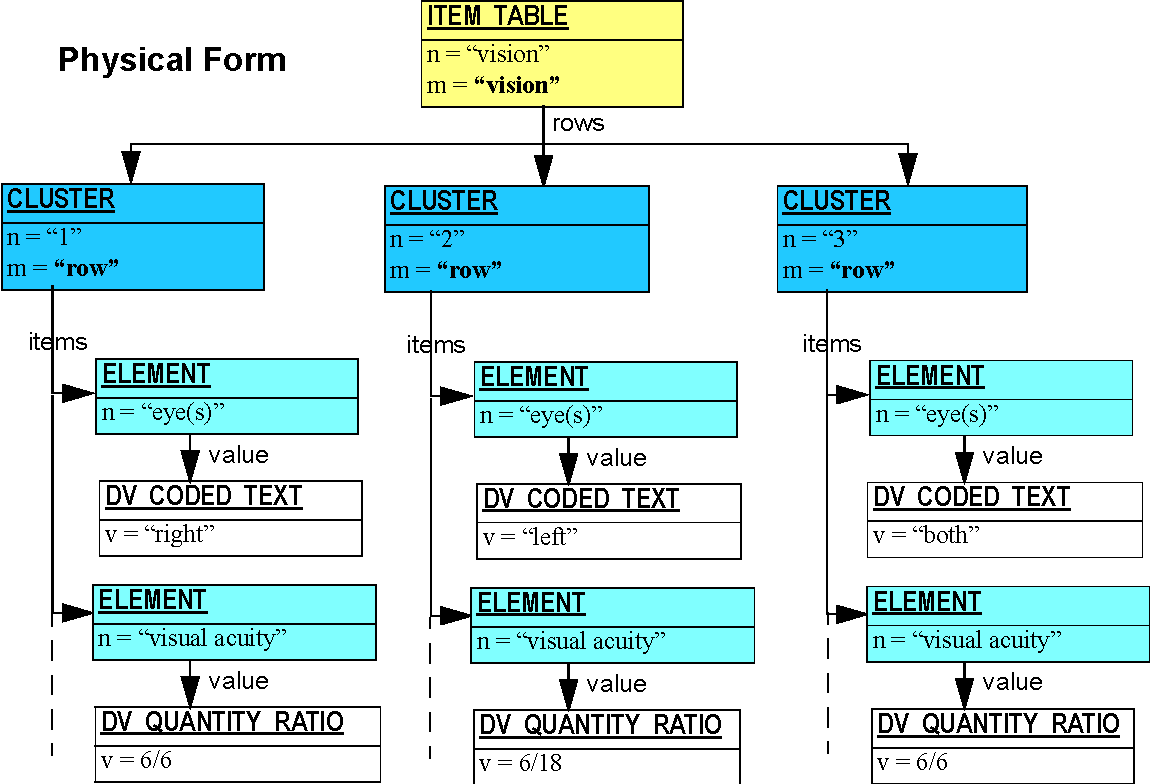
Logical Form
FIGURE 5 ITEM_TABLE Instance Structure
4.4.4 ITEM_TREE Instance Structure
FIGURE 6 illustrates te logical and physical form of an example ITEM_TREE instance, representing a biochemistry result.
| Vision | |
| Eye(s) | visual acuity |
| Right | 6/6 |
| Left | 6/18 |
| Both | 6/6 |
Date of Issue: 26 Sep 2006 Page 20 of 39 Editors:{T Beale, S Heard}, {D Kalra, D Lloyd}
© 2003-2007 The openEHR Foundation. email: info@openEHR.org web: http://www.openEHR.org
Data Structures Information Model Item Structure Package Rev 1.7
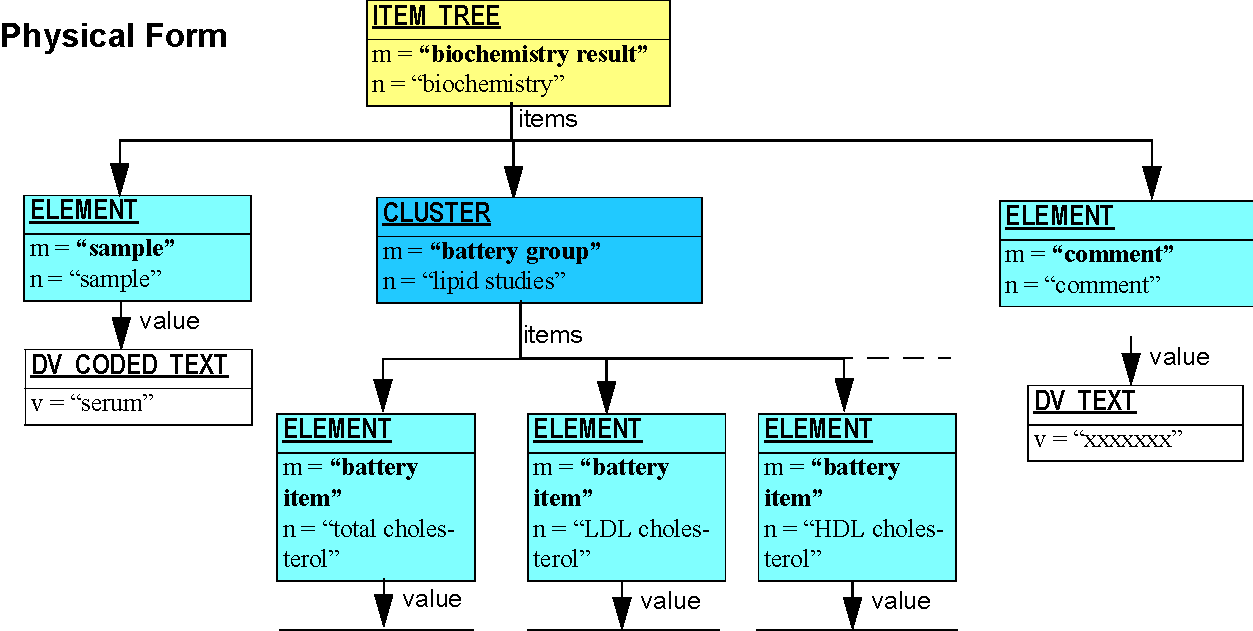
value
value
DV_TEXT
v = “xxxxxxx”
value value value
DV_QUANTITY DV_QUANTITY DV_QUANTITY
v = XX v = XX v = XX
BIOCHEMISTRY RESULT
sample = serum lipid studies
Logical Form
total cholesterol = 6.1 mmol/L HDL cholesterol = 0.9 mmol/L LDL cholesterol = 5.2 mmol/L
comment: high cardiac risk
FIGURE 6 ITEM_TREE Instance Structure
Editors:{T Beale, S Heard}, {D Kalra, D Lloyd} Page 21 of 39 Date of Issue: 26 Sep 2006
© 2003-2007 The openEHR Foundation. email: info@openEHR.org web: http://www.openEHR.org
Item Structure Package Data Structures Information Model Rev 1.7
Date of Issue: 26 Sep 2006 Page 22 of 39 Editors:{T Beale, S Heard}, {D Kalra, D Lloyd}
© 2003-2007 The openEHR Foundation. email: info@openEHR.org web: http://www.openEHR.org
Data Structures Information Model Representation Package Rev 1.7
Representation Package
5.1 Overview
This package contains classes for a simple hierarchical representation of any data structure, as shown in FIGURE 7 . These classes are compatible with the CEN EN13606 classes of the same names, and instances can be losslessly generated to and from EN13606 instances structures.
LOCATABLE (rm.common.archetyped)
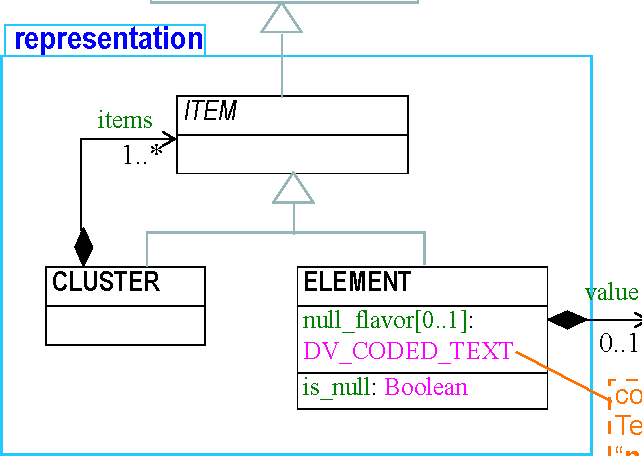
DATA_VALUE
(rm.data_types.basic)
coded by openEHR Terminology group “null flavour”
FIGURE 7 rm.data_structures.representation Package
5.2 Class Descriptions
5.2.1 ITEM Class
| CLASS | ITEM (abstract) | |
|---|---|---|
| Purpose | The abstract parent of CLUSTERand ELEMENT representation classes. | |
| CEN | ITEM class | |
| OMG HDTF | COAS::Observation | |
| Synapses | Item class | |
| GEHR | G1_HIERARCHICAL_ITEM | |
| HL7v3 | n/a | |
| Inherit | LOCATABLE | |
| Attributes | Signature | Meaning |
Editors:{T Beale, S Heard}, {D Kalra, D Lloyd} Page 23 of 39 Date of Issue: 26 Sep 2006
Representation Package Data Structures Information Model Rev 1.7
5.2.2 CLUSTER Class
| CLASS | CLUSTER | |
|---|---|---|
| Purpose | The grouping variant of ITEM, which may contain further instances of ITEM, in an ordered list. | |
| CEN | (ENV 13606:2000) ClusterOCC class; (prEN 13606:2006) | |
| OMG HDTF | COAS::CompositeObservation | |
| Synapses | Compound class | |
| GEHR | G1_HIERARCHICAL_GROUP | |
| HL7v3 | Act_context | |
| Inherit | ITEM | |
| Attributes | Signature | Meaning |
| items: List<ITEM> | Ordered list of items -CLUSTER or ELEMENT objects - under this CLUSTER. | |
| Invariants | Items_non_empty: items /= Void and then not items.empty | |
Date of Issue: 26 Sep 2006 Page 24 of 39 Editors:{T Beale, S Heard}, {D Kalra, D Lloyd}
© 2003-2007 The openEHR Foundation. email: info@openEHR.org web: http://www.openEHR.org
| Data Structures Information Model | Representation Package | |
|---|---|---|
| Rev 1.7 | ||
| 5.2.3 | ELEMENT Class | |
| CLASS | ELEMENT | |
|---|---|---|
| Purpose | The leaf variant of ITEM, to which a DATA_VALUE instance is attached. | |
| CEN | DataItem class | |
| OMG HDTF | COAS::AtomicObservation | |
| Synapses | Element class | |
| GEHR | G1_HIERARCHICAL_VALUE | |
| HL7v3 | Act | |
| Inherit | ITEM | |
| Attributes | Signature | Meaning |
| 0..1 (cond) | value: DATA_VALUE | data value of this leaf |
| 0..1 (cond) | null_flavor: DV_CODED_TEXT | flavour of null value, e.g. indeterminate, not asked etc |
| Functions | Signature | Meaning |
| 1..1 | is_null: Boolean | True if value logically not known, e.g. if indeterminate, not asked etc. |
| Invariants | Is_null_valid: is_null = (value = Void) Null_flavor_indicated: is_null xor null_flavour = Void Null_flavour_valid: is_null implies terminology(Terminology_id_openehr).has_code_for_group_id (Group_id_null_flavour, null_flavor.defining_code) | |
Editors:{T Beale, S Heard}, {D Kalra, D Lloyd} Page 25 of 39 Date of Issue: 26 Sep 2006
© 2003-2007 The openEHR Foundation. email: info@openEHR.org web: http://www.openEHR.org
Representation Package Data Structures Information Model Rev 1.7
Date of Issue: 26 Sep 2006 Page 26 of 39 Editors:{T Beale, S Heard}, {D Kalra, D Lloyd}
© 2003-2007 The openEHR Foundation. email: info@openEHR.org web: http://www.openEHR.org
Data Structures Information Model History Package Rev 1.7
History Package
6.1 Overview
The history package defines classes which formalise the concept of past, linear time, via which historical data of any structural complexity can be recorded. It supports both instantaneous and interval event samples within periodic and aperiodic series. Data recorded in interval events are tagged with a mathematical function, including ‘point-in-time’, ‘mean’, ‘delta’ and so on, as defined by the openEHR “event math function” vocabulary. It also supports the inclusion of “summary” data, i.e. a textual or image item which summarises in some way the entire history.
Regardless of whether the actual data consist of a single sample or many, they are represented in the same way: as a history of events, i.e. as a time series, allowing all software to access data in a uniform way, whether it is a single measurement of weight, a long series of three- or four-dimensional images, or even a series of encapsulated multimedia items.
The model defines the constrained generic (otherwise known as ‘template’ or ‘parameterised’) types HISTORY<T>, EVENT<T>, POINT_EVENT<T>, and INTERVAL_EVENT<T> where the type parameter is constrained to the ITEM_STRUCTURE type, and defines the type of the data recorded in an instance of HISTORY. The effect is that repeated instances of spatially complex data can recur in time, corresponding to the way data are actually measured. An aperiodic series of POINT_EVENT instances would typically be used to represent manual measurements repeated in time. Periodic histories of INTERVAL_EVENT instances would typically be used to represent vital signs monitor output (which is usually delivered in averaged form potentially with additional minimum and maximum values).
As with all other parts of the openEHR reference model, the History package is designed for archetyping; archetypes define the domain semantics of HISTORY instances. The history package is shown in FIGURE 8.
6.1.1 Semantics
Basic Semantics
The intention of the History model is to represent time-based data for which every sample in the series is a measurement of the same phenomenon (e.g. patient heartrate) and is obtained using the same measurement method (e.g. pulse oximeter). Samples taken in this way can be reliably treated as representing changes in a phenomenon over time, and accordingly can be safely used for time-based computation, such as graphing, statistical analysis and so on. A History can contain any mixture of POINT_EVENT and INTERVAL_EVENT instances. Clearly it is impossible for the model to guarantee completely correct usage on its own, however there two major safeguards.
Firstly, the use of generic types forces the type of the data in each Event to be the same. A History of type HISTORY<ITEM_LIST> therefore constrains the type of the data at each Event (EVENT.item) to be of type ITEM_LIST and nothing else.
Secondly, the use of archetyping (typically within openEHR Observation archetypes) ensures the actual structure of the ITEM_STRUCTURE subtype is defined in the same way for every sample - e.g. a two-item list representing systolic and diastolic blood pressure.
Timing
An instance of the HISTORY class contains the origin: DV_DATE_TIME attribute, indicating what is considered the ‘0-point’ of the time series, and a series of instances of the EVENT subtype, each containing a time: DV_DATE_TIME attribute representing the absolute time of the event. The relative off-
Editors:{T Beale, S Heard}, {D Kalra, D Lloyd} Page 27 of 39 Date of Issue: 26 Sep 2006
© 2003-2007 The openEHR Foundation. email: info@openEHR.org web: http://www.openEHR.org
History Package Data Structures Information Model Rev 1.7
LOCATABLE (rm.common.archetyped)
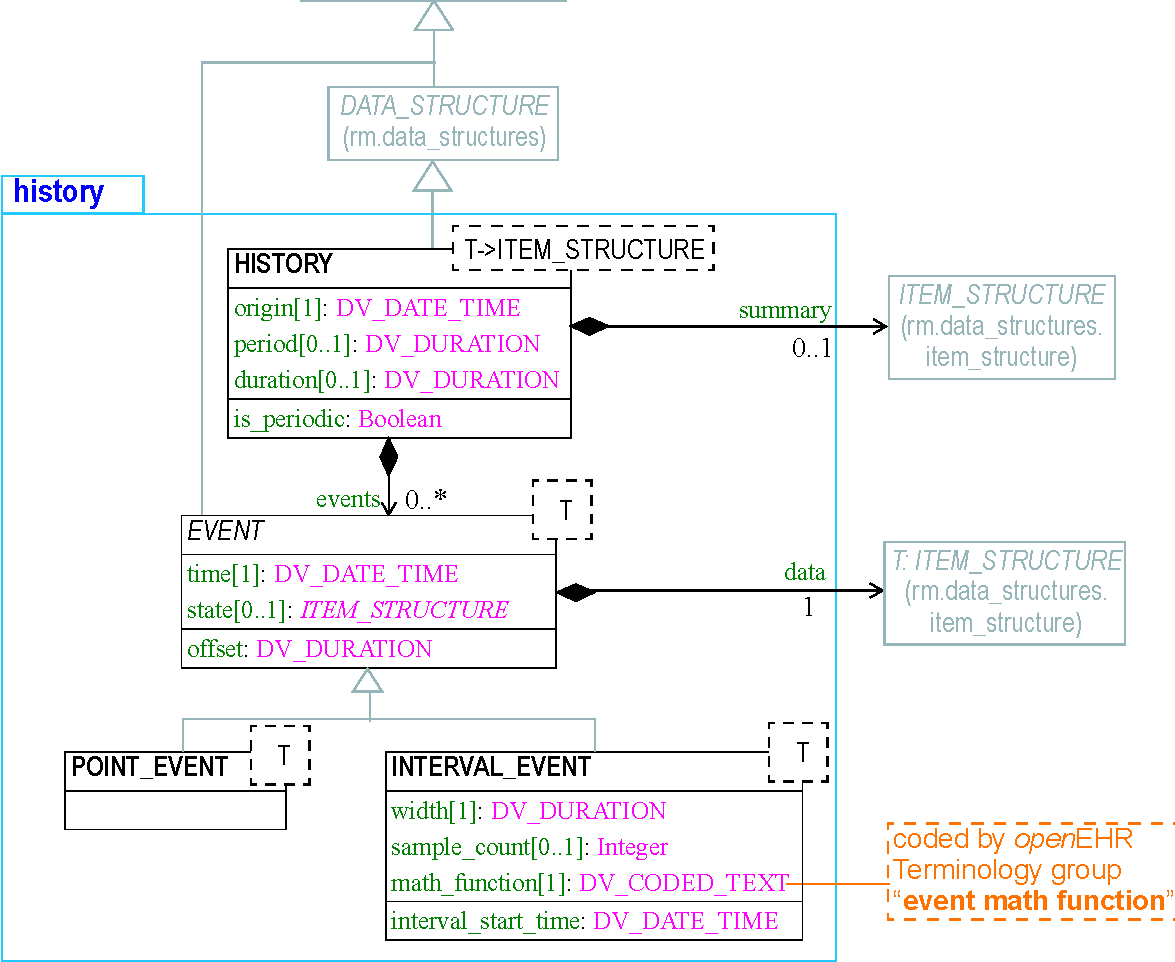
FIGURE 8 rm.data_structures.history Package
set of any Event is computed as the difference between the EVENT.time and HISTORY.origin by the EVENT.offset function. For Interval events (i.e. instances of INTERVAL_EVENT), the time attribute always refers to the end time of the event, since this is the time at which the data (e.g. average) are true.
The origin time of a History does not have to be the time of the first sample - it might be the time of an event such as child-birth with respect to which the samples are recorded, e.g. Apgar1 scores at 1 and 3 minute offsets. Periodicity and aperiodicity are expressed via the is_periodic and period attributes. For a periodic time-series, period is set to the period duration value and is_periodic returns True. The total duration of the History is given by the HISTORY.duration function. FIGURE 9 illus trates a number of variations in History periodicity and Event type.
Point Events
The simplest kind of Event in a History is a “point” event, expressed by instances of the class POINT_EVENT, representing an instantaneous value. A History instance many be composed solely of Point events, as would be the case with a number of blood pressure values measured over time as the patient changes position. An Apgar result is a typical example of aperiodic point data, typically con
1. A 0-10 score indicating the health of a newborn based on breathing, heartrate, colour, muscle-tone and reflexes
Date of Issue: 26 Sep 2006 Page 28 of 39 Editors:{T Beale, S Heard}, {D Kalra, D Lloyd}
© 2003-2007 The openEHR Foundation. email: info@openEHR.org web: http://www.openEHR.org
Data Structures Information Model History Package Rev 1.7
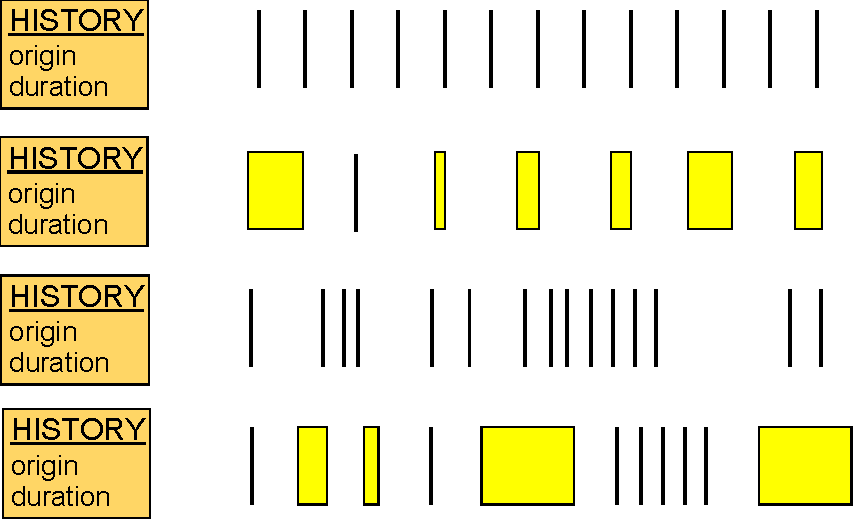
periodic, point events
periodic, interval events
aperiodic, point events
aperiodic, mixed point and interval events
FIGURE 9 Variation in History periodicity and Event width
sisting of 2 or 3 events, each containing 5 values and a 6th value repersenting the Apgar score for that time point. Point data may also be available from monitoring devices. For fine-granularity (e.g. 1 second) data, the number of samples may be too voluminous for the health record, and more efficient recording in the form of summary Interval events (see below) might be desired. FIGURE 10 illus trates the structure of a HISTORY containing POINT_EVENTs.
blood pressure
 t
t
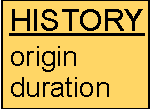
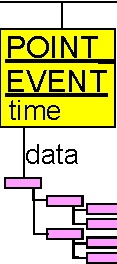
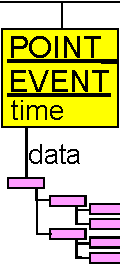
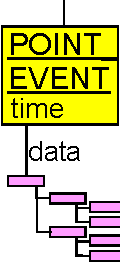
FIGURE 10 Structure of HISTORY<T> of POINT_EVENTs
Interval Events
Instances of the INTERVAL_EVENT class are used to express values corresponding to an interval in time. The INTERVAL_EVENT.width attribute defines the duration of the interval; and the inherited time value corresponds to the trailing edge of the event.
The meaning of an Interval event in this model is that the values effectively summarise actual instantaneous values of a datum that have occurred during the period of the event interval. The mathematical meaning of the data of any particular interval event is given by the math_function attribute. This is coded by the openEHR Terminology group “event math function”, and takes values such as “minimum”, “maximum”, “average”, “delta” and so on. The particular math functions used in each Interval event in a History may vary throughout the History; for example, one 4-hour Interval event might contain data representing average values, while a following event might contain data representing
Editors:{T Beale, S Heard}, {D Kalra, D Lloyd} Page 29 of 39 Date of Issue: 26 Sep 2006
© 2003-2007 The openEHR Foundation. email: info@openEHR.org web: http://www.openEHR.org
History Package Data Structures Information Model Rev 1.7
maximum values. Such data can be conveniently used for generating sophisticated graphs of the underlying datum over time. FIGURE 11 illustrates a History containing 2 pairs of 4-hour blood pres sure Interval events, with each pair containing maximum and mean blood pressure value structures for +4h and +8h timepoints (each of which consist of a systolic and diastolic value).
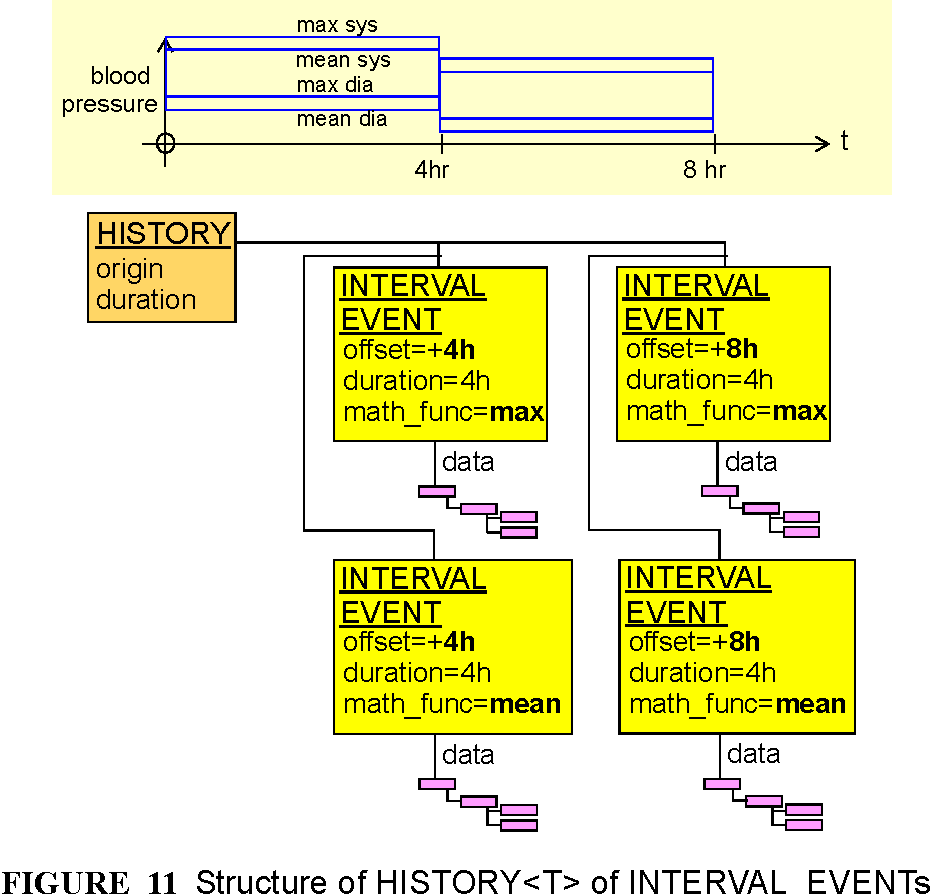
Interval events can overlap other interval or point events within the same History. A common situation where this occurs is with measurement of different periods of vital signs, such as 4-hourly blood pressure events, overlapped by a 24-hour event which contains the values over a period of 6 x 4 hour periods. In general a long Interval event can overlap any combination of Point or Interval events, as shown in FIGURE 12 .

Change Data
One subcategory of interval data that deserves mention is change data. There are three event math function terms used for indicating changes in data values as follows:
• “change”: this means that the value recorded is the difference between the value now and the value some time previously. It can be positive or negative;
Date of Issue: 26 Sep 2006 Page 30 of 39 Editors:{T Beale, S Heard}, {D Kalra, D Lloyd}
© 2003-2007 The openEHR Foundation. email: info@openEHR.org web: http://www.openEHR.org
Data Structures Information Model History Package Rev 1.7
- “increase”: the value recorded for the change is positive. The name (i.e. ELEMENT.name) chosen for the item in an archetype carries the semantic of positivity e.g. "increase of ....; rise of....; ....gain" etc;
- “decrease”: the value recorded for the change is positive. But the name chosen for the item carries the semantic of negativity e.g. "decrease of ....; fall of ....; .... loss".
The following examples show how the data and these math functions are coordinated.
- weight last week was 76 kg. Wait this week = 74 kg. Possible instances:
- weight last week was 80 kg. Weight this week = 83 kg. Possible instances:
| Item Name in Archetype | Value stored | Type | Math Function |
|---|---|---|---|
| “weight change” | + 2kg | DV_QUANTITY | “change” |
| “weight loss” | (+)2kg | DV_QUANTITY | “decrease” |
| “weight loss” | True | Boolean | “decrease” |
| Item Name in Archetype | Value stored | Type | Math Function |
|---|---|---|---|
| “weight change” | (+)3kg | DV_QUANTITY | “change” |
| “weight increase” | (+)3kg | DV_QUANTITY | “increase” |
| “weight gain” | True | Boolean | “decrease” |
The use of these math function indicators allows the correct representation of change values, no matter how they were captured, in a computable form.
Summary Event Data
A relatively common situation particularly in laboratory testing is the existence of a “summarising” event which accompanies more detailed historical data. Examples where this arises include:1
- a series of exams with a single radiologist report for all of them (the report might include one or more key images);
- graphical summary of a dynamic challenge test such as Glucose tolerance test;
- some comment about the pattern of values on a set of observed values in series.
Such data are accommodated within the model via the optional HISTORY.summary attribute, which is itself a structure, archetypable separately from the structure of the main data. In the first example above, the summary data might consist of an ITEM_SINGLE object containing a textual report; in the second, an ITEM_SINGLE object containing a image within a DV_MULTIMEDIA instance.
Efficient Representation of Fine-grained Device Data
A useful practical consequence of the of Interval Events is that it allows long periods of relatively stable data to be represented with a single Interval event, while interesting perturbations will be repre sented with a number of fine-grained Interval or Point Events. In the example in FIGURE 13 5 Event instances are used represent 4 hours of data consisting to 14,400 x 1 second samples from a blood pressure monitor. The optional INTERVAL_EVENT.sample_count attribute can be used to record the number of original samples summarised in the event. In the illustration, the math_function is shown as mean; clearly in the first long period, the monitored datum was not absolutely flat. The implication
1. Examples provided by G Grieve of Kestral Computing, Australia
Editors:{T Beale, S Heard}, {D Kalra, D Lloyd} Page 31 of 39 Date of Issue: 26 Sep 2006
© 2003-2007 The openEHR Foundation. email: info@openEHR.org web: http://www.openEHR.org
History Package Data Structures Information Model Rev 1.7
is that the recording software was configured to regard variations in a small band (e.g. 5mm Hg) as insignificant, and only to create new Event objects when the underlying values moved outside the band. Another approach woould have been to create two Interval Event objects for each long period, one giving minimum value, the other maxium value, still based on the principle of generating one such pair for periods when the underlying data remained within specified limits. Regardless of the details, this general approach provides a way to include hours of fine-grained data from devices like vital signs monitors in very little space; the data simply need to be transfomed into equivalent openEHR History form first.
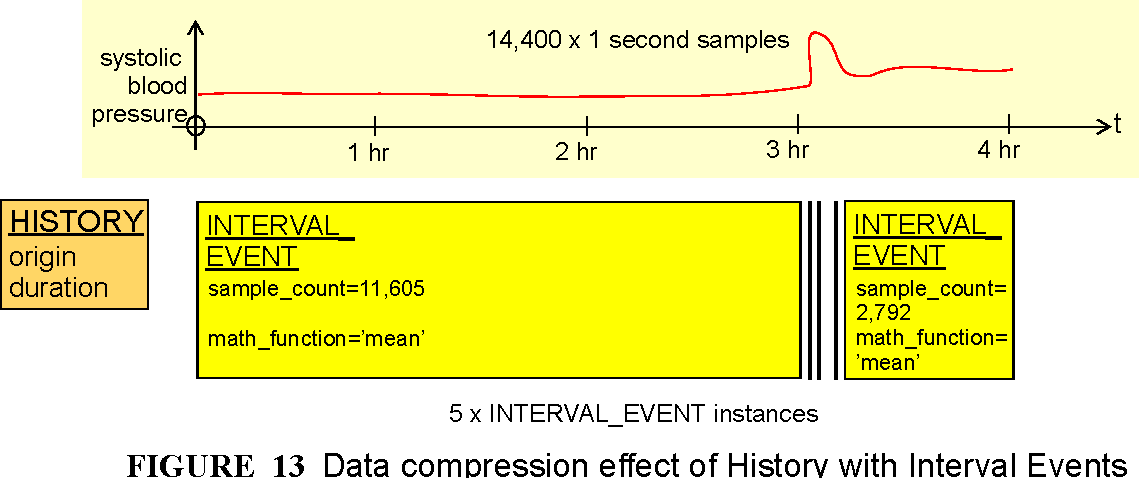
5 x INTERVAL_EVENT instances
State
A feature particular to a model of recording historical data for scientific and clinical use is the ability to record ‘state’. In openEHR, ‘state’ is understood as information pertinent to the correct interpretation of the primary data. A simple example is where the primary datum is heartrate; useful state data would be the level of exertion of the subject (resting, after 3 minutes cycling etc). In clinical recording situations, the state data is often crucial to the safe use of the primary data, since the latter might be normal or abnormal depending on the patient state. In openEHR there are two ways of recording state. One is via the use of a separate HISTORY structure within the OBSERVATION class (see ehr.composition.content.entry package). The other is via the use of the state attribute of type ITEM_STRUCTURE defined in the class EVENT itself. Experience with openEHR archetypes and systems has shown that the latter method corresponds to the most common clinical need, which is to be able to record the state at the time of the event (the other method allows for the recording of independent state events). A simple example is the recording of 3 glucose levels during a glucose tolerance test. The state information for each event is, respectively (in a typical test):
- 0-minute sample: “post 8-hour fast”;
- 1-hour sample: “post 75g oral glucose challenge”;
- 2-hour sample: “post 75g oral glucose challenge”.
Date of Issue: 26 Sep 2006 Page 32 of 39 Editors:{T Beale, S Heard}, {D Kalra, D Lloyd}
© 2003-2007 The openEHR Foundation. email: info@openEHR.org web: http://www.openEHR.org
| Data Structures Information Model | History Package |
| Rev 1.7 | |
| The History structure for this example is illustrated in FIGURE 14. |
x 9.0 mmol/l
blood
x 6.0 mmol/l
glucose  x 4.5 mmol/l
x 4.5 mmol/l
t
0 min 1 hr 2 hr

Snomed::10000014 Snomed::10000003 Snomed::10000003 “post 8hr fast” “post 75mg glucose “post 75mg glucose challenge” challenge”
FIGURE 14 State in HISTORY
6.2 Class Descriptions
6.2.1 HISTORY<T: ITEM_STRUCTURE> Class
| CLASS | HISTORY<T: ITEM_STRUCTURE> | |
|---|---|---|
| Purpose | Root object of a linear history, i.e. time series structure. For a periodic series of events, period will be set, and the time of each Event in the History must correspond; i.e. the EVENT.offset must be a multiple of period for each Event. Missing events in a period History are however allowed. | |
| CEN | Time was encoded as part of the Item structure. | |
| GEHR | Time was encoded as part of the G1_HIERARCHICAL_PROPOSITION structure. | |
| HL7v3 | The data type HIST<T>is equivalent in intention to HISTORY<T>for histories of primitive values; for histories of complex data, Act/Act-relationship structures have to be used. | |
| Inherit | DATA_STRUCTURE | |
| Attributes | Signature | Meaning |
| 1..1 | origin: DV_DATE_TIME | Time origin of this event history. The first event is not necessarily at the origin point. |
| 0..1 | events: List <EVENT<T>> | The events in the series. |
Editors:{T Beale, S Heard}, {D Kalra, D Lloyd} Page 33 of 39 Date of Issue: 26 Sep 2006
History Package Data Structures Information Model Rev 1.7
| CLASS | HISTORY<T: ITEM_STRUCTURE> | |
|---|---|---|
| 0..1 | period: DV_DURATION | Period between samples in this segment if periodic. |
| 0..1 | duration: DV_DURATION | Duration of the entire History; either corresponds to the duration of all the events, and/or the duration represented by the summary, if it exists. |
| 0..1 | summary: ITEM_STRUCTURE | Optional summary data expressing e.g. text or image which summarises entire History. |
| Functions | Signature | Meaning |
| 1..1 | is_periodic: Boolean | Indicates whether history is periodic. |
| as_hierarchy: CLUSTER | Generate a CEN EN13606-compatible hierarchy of the physical representation. | |
| Invariants | origin_exists: origin /= Void events_exists: (events /= Void and then not events.is_empty) or summary /= Void periodic_validity: is_periodic xor period = Void period_consistency: is_periodic implies events.for_all (e: EVENT | e.offset.to_seconds.mod(period.to_seconds) = 0) | |
6.2.2 EVENT <T: ITEM_STRUCTURE> Class
| CLASS | EVENT <T: ITEM_STRUCTURE> (abstract) | |
|---|---|---|
| Purpose | Defines the abstract notion of a single event in a series. This class is generic, allowing types to be generated which are locked to particular spatial types, such as EVENT<ITEM_LIST>. Subtypes express point or intveral data. | |
| HL7v3 | The data type HistoryItem HXIT<T> is close to EVENT<T> in its intent. | |
| Inherit | LOCATABLE | |
| Attributes | Signature | Meaning |
| 1..1 | time: DV_DATE_TIME | Time of this event. If the width is non-zero, it is the time point of the trailing edge of the event. |
| 1..1 | data: T | The data of this event. |
| 0..1 | state: ITEM_STRUCTURE | Optional state data for this event. |
| Functions | Signature | Meaning |
Date of Issue: 26 Sep 2006 Page 34 of 39 Editors:{T Beale, S Heard}, {D Kalra, D Lloyd}
Data Structures Information Model History Package Rev 1.7
| CLASS | EVENT <T: ITEM_STRUCTURE> (abstract) | |
|---|---|---|
| (redefined) | parent: HISTORY<T> | Redefinition of LOCATABLE.parent to be of type HISTORY. |
| 1..1 | offset: DV_DURATION | Offset of this event from origin, computed as time.diff(parent.origin) |
| Invariants | Time_exists: time /= Void Data_exists: data /= Void Offset_validity: offset /= Void and then offset = time.diff(parent.origin) | |
6.2.3 POINT_EVENT <T: ITEM_STRUCTURE> Class
| CLASS | POINT_EVENT <T: ITEM_STRUCTURE> | |
|---|---|---|
| Purpose | Defines a single point event in a series. | |
| Inherit | EVENT | |
| Attributes | Signature | Meaning |
| Invariants | ||
6.2.4 INTERVAL_EVENT <T: ITEM_STRUCTURE> Class
| CLASS | INTERVAL_EVENT <T: ITEM_STRUCTURE> | |
|---|---|---|
| Purpose | Defines a single interval event in a series. | |
| Inherit | EVENT | |
| Attributes | Signature | Meaning |
| 1..1 | width: DV_DURATION | Length of the interval during which the state was true. Void if an instantaneous event. |
| 1..1 | math_function: DV_CODED_TEXT | Mathematical function of the data of this event, e.g. “maximum”, “mean” etc. Coded using openEHR Terminology group “event math function”. |
| 0..1 | sample_count: Integer | Optional count of original samples to which this event corresponds. |
| Functions | Signature | Meaning |
| 1..1 | interval_start_time: DV_DATE_TIME | Start time of the interval of this event. |
Editors:{T Beale, S Heard}, {D Kalra, D Lloyd} Page 35 of 39 Date of Issue: 26 Sep 2006
History Package Data Structures Information Model Rev 1.7

Width_valid: width /= Void Math_function_validity: terminology(Terminology_id_openehr). has_code_for_group_id(Group_id_event_math_function, math_function.defining_code) Interval_start_time_valid: interval_start_time /= Void and interval_start_time = time - width
6.3 History Instance Structures
6.3.1 Single Sample
FIGURE 15 illustrates a single weight measurement. The Event objects contain the timing information, which in this case is simply the time of measurement (the origin).

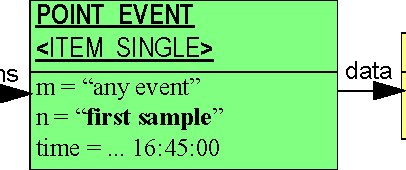 ITEM_SINGLE
ITEM_SINGLE
itemdata items
m = “weight” n = “weight”
6.3.2 5-minute Blood Pressure Averages
FIGURE 16 illustrates two Interval events representing 5 minute blood pressure averages, the first at 5 minutes’ offset from an initial event and lasting 5 minutes, the second 5 minutes later.
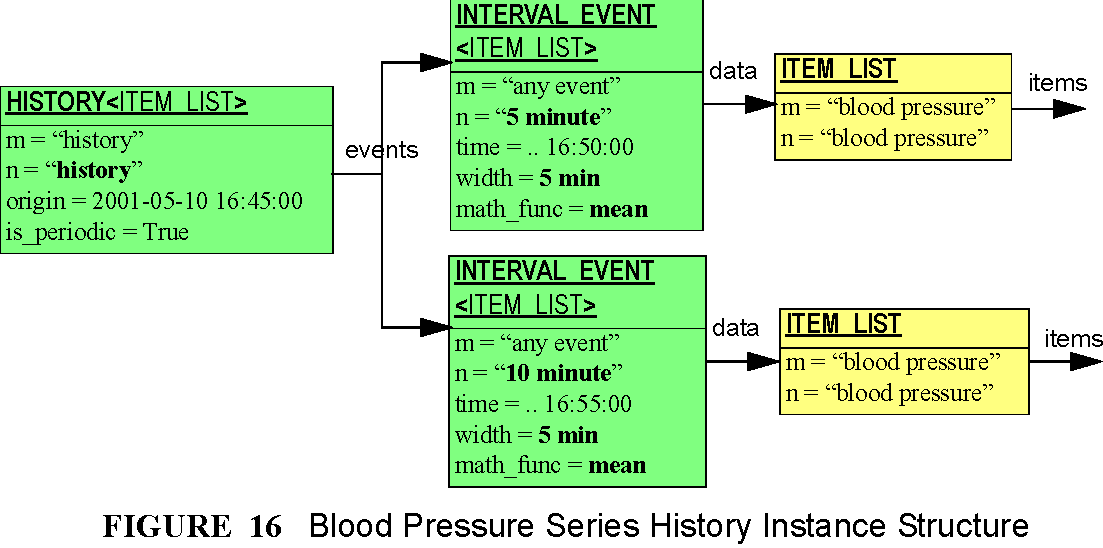
Date of Issue: 26 Sep 2006 Page 36 of 39 Editors:{T Beale, S Heard}, {D Kalra, D Lloyd}
© 2003-2007 The openEHR Foundation. email: info@openEHR.org web: http://www.openEHR.org
Data Structures Information Model References Rev 1.7
A References
A.1 General
1 Beale T. Archetypes: Constraint-based Domain Models for Future-proof Information Systems. See http://www.deepthought.com.au/it/archetypes.html .
2 Beale T et al. Design Principles for the EHR. See http://www.deepthought.com.au/openEHR .
3 Schloeffel P. (Editor). Requirements for an Electronic Health Record Reference Architecture. International Standards Organisation, Australia; Feb 2002; ISO TC 215/SC N; ISO/WD 18308.
A.2 European Projects
4 Dixon R., Grubb P.A., Lloyd D., and Kalra D. Consolidated List of Requirements. EHCR Support Action Deliverable 1.4. European Commission DGXIII, Brussels; May 200159pp Available from http://www.chime.ucl.ac.uk/HealthI/EHCR-SupA/del1-4v1_3.PDF .
5 Dixon R, Grubb P, Lloyd D. EHCR Support Action Deliverable 3.5: "Final Recommendations to CEN for future work". Oct 2000. Available at http://www.chime.ucl.ac.uk/HealthI/EHCR SupA/documents.htm .
6 Dixon R, Grubb P, Lloyd D. EHCR Support Action Deliverable 2.4 "Guidelines on Interpretation and implementation of CEN EHCRA". Oct 2000. Available at ht tp://www.chime.ucl.ac.uk/HealthI/EHCR-SupA/documents.htm .
7 Ingram D. The Good European Health Record Project. Laires, Laderia Christensen, Eds. Health in the New Communications Age. Amsterdam: IOS Press; 1995; pp. 66-74.
8 Deliverable 19,20,24: GEHR Architecture. GEHR Project 30/6/1995
A.3 CEN
9 ENV 13606-1 - Electronic healthcare record communication - Part 1: Extended architecture. CEN/ TC 251 Health Informatics Technical Committee.
10 ENV 13606-4 -Electronic Healthcare Record Communication standard Part 4: Messages for the exchange of information. CEN/ TC 251 Health Informatics Technical Committee.
A.4 OMG
11 CORBAmed document: Person Identification Service. (March 1999). (Authors?)
12 CORBAmed document: Lexicon Query Service. (March 1999). (Authors?)
A.5 Software Engineering
13 Meyer B. Object-oriented Software Construction, 2nd Ed.
Prentice Hall 1997
14 Fowler M. Analysis Patterns: Reusable Object Models. Addison Wesley 1997
Editors:{T Beale, S Heard}, {D Kalra, D Lloyd} Page 37 of 39 Date of Issue: 26 Sep 2006
© 2003-2007 The openEHR Foundation. email: info@openEHR.org web: http://www.openEHR.org
References Data Structures Information Model Rev 1.7
15 Fowler M, Scott K. UML Distilled (2nd Ed.). Addison Wesley Longman 2000
A.6 Resources
16 IANA - http://www.iana.org/ .
Date of Issue: 26 Sep 2006 Page 38 of 39 Editors:{T Beale, S Heard}, {D Kalra, D Lloyd}
© 2003-2007 The openEHR Foundation. email: info@openEHR.org web: http://www.openEHR.org
Data Structures Information Model
Rev 1.7
END OF DOCUMENT
Editors:{T Beale, S Heard}, {D Kalra, D Lloyd} Page 39 of 39 Date of Issue: 26 Sep 2006
© 2003-2007 The openEHR Foundation. email: info@openEHR.org web: http://www.openEHR.org
